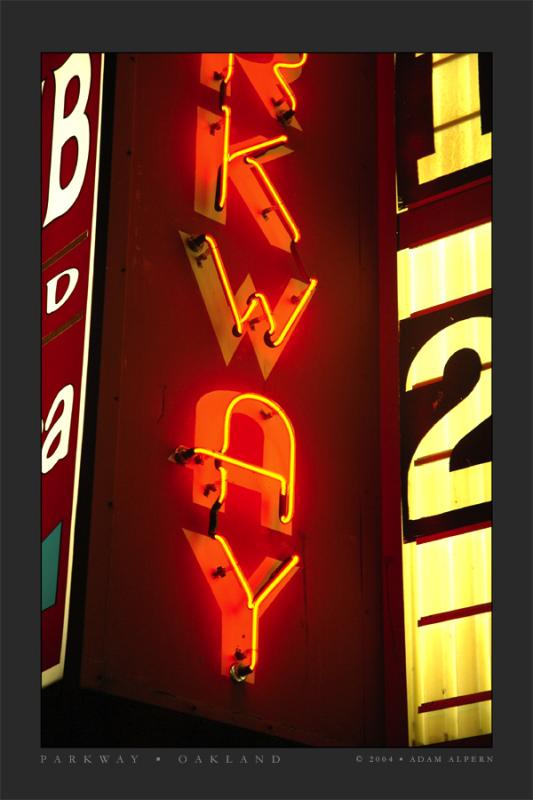 This will be one of two posts on urbanism by me. The other will involve urban renewal & Obama. I just found out that The Parkway theatre in Oakland is closing. It was divey, but you could get food and wine/beer and lounge on second-hand couches seeing films at the very tail end of their theatrical release. I can recall many a rainy wintry night seeing a film as a diversion during the week. I received this e-mail from the CEO and the President tonight:
This will be one of two posts on urbanism by me. The other will involve urban renewal & Obama. I just found out that The Parkway theatre in Oakland is closing. It was divey, but you could get food and wine/beer and lounge on second-hand couches seeing films at the very tail end of their theatrical release. I can recall many a rainy wintry night seeing a film as a diversion during the week. I received this e-mail from the CEO and the President tonight:
“After more than twelve years of serving the great cultural crossroad of Oakland, the Parkway Speakeasy Theater will be closing at the end of business day this Sunday, March 22, 2009. From African Diaspora to Thrillville to lesbian fashion shows and educational porn, the Parkway has offered an eclectic array of movies and events. It was the first theater in California to offer food, beer and wine service in a lounge style movie theater. With a nudge or a push from the community, there was little programming the Parkway theater would not try in order to better be a community center and a safe haven for diverse ideas. The Parkway brought Baby Brigade for the shuttered and abandoned parents of newborns, the first international black gay, lesbian, bi-sexual, transgender film festival and Sunday Salon, a free event for cultural and community enhancement. We, at the Parkway Speakeasy Theater, are deeply proud of the Parkway and will profoundly miss serving its community. Thank you for your patronage.”–Kyle & Catherine Fischer
(Sidenote: I missed the screenings of educational porn.) The Parkway is in a boundary zone in the San Antonio district of Oakland, east of Lake Merritt. It’s a diverse area, where Eastlake (with Southeast Asian immigrants) and the middle class Ivy Hill and Cleveland Heights neighborhoods converge. It’s quite far from the notorious San Antonio neighborhood known as the Twomps. I found The Parkway to be a reason to head to that corner of Oakland and this made me think of the impact on the neighborhood this closure will have.
Closer to my Eastbay digs is The Elmwood, which owes its existence to a business improvement district (BID) model. According to a case study:
“Theaters-especially those of historical significance (Elmwood is a landmark)-play a unique role in commercial districts, and their multiplier benefits are widely recognized. It was not surprising that merchants were willing to finance the purchase of the theater, given the research that has been done on the importance of theaters in commercial districts, plus their own experiences. The National Association of Theater Operators had shown that about half of evening moviegoers can be expected to have dinner at a restaurant located within blocks of the theater. Studies also showed that a high proportion of patrons also visit coffee houses and dessert establishments. Further, the volume of ATM transactions at a bank in the neighborhood surrounding the Elmwood declined by more than 1000 per month after the closing of the theater. It was evident to area businesses that it was in their self-interest to revive the theater as a main attraction in the neighborhood. Their investment is paying off.”
From my experiences, the more upscale Elmwood district with more shops and restaurants really benefits from the presence of the theater, despite parking being at a premium. My PO box is at the Elmwood station on College, I pay my Visa bill at the Wells Fargo, and I’ve frequented many restaurants in the area. Unfortunately, draconian zoning regs. caused an indie hardware store to close (a fave of mine), which was also a draw to the neighborhood.
The neighborhood surrounding The Parkway didn’t have a strong sense of community around it, as it was at the interstices of several neighborhoods. It was at the crossroads where the Merritt Café, the WAMU, the Albertsons, the Vietnamese pho place, the Church’s Fried Chicken, and the auto parts chain all resided, but the fact of the matter is it isn’t an inviting place to walk around and hang out. I’m interested in the interface between commerce and community, but I’m wary of too much top-down planning.
I wonder what are the requirements for community stabilization and what should be researched in this area?
I may have to see Revolutionary Road tomorrow at 7 for nostalgia’s sake.

Comments